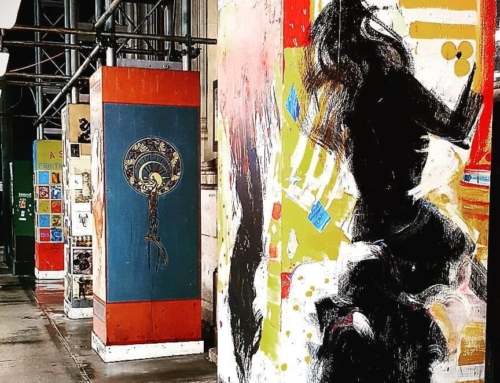 |
| Warming up before the show in the bata de cola. |
This summer, I’ve been dancing quite a bit in a bata de cola (dress with a train). It’s probably one of the most technically demanding skills in flamenco and requires an immense amount of corporal control. Since I’m spending so much time with it, I wanted to share a bit about my experiences with the bata and some of the history. This will be a two part blog post, so stay tuned for part 2!
I remember clearly the first time I saw a dancer perform with a bata de cola. It was shortly after I’d begun dancing flamenco, and I went to a few shows at Festival Flamenco de Alburquerque with my mom. We were both in awe of the way the dancer maneuvered the ruffled fabric–it was as if the dress were a partner and they were perfectly in unison, yet they each had their own personality. Years later, I realized that dancer was Rosario Toledo, who would become one of my mentors in Sevilla. I’ve now seen her perform numerous times with a bata, and she is still one of my favorite dancers with bata–in her alegrías, she picks up the ruffles, holds them just right so they look like a face, and she proceeds to have a mimed conversation with the bata, inclusive with head nodding and shaking of the bata and a couple of times the poor bata gets a smack on the head. She makes the bata come alive and take on a character of its own with humor and wit, just as an alegrías should have (and who would expect any less from a gaditana (Cádiz native)).
| Rosario Toledo dancing in her bata de cola. |
A little history:
The first dancer recorded to dance on stage in a bata de cola was La Mejorana. She was born in Cádiz in 1862 in the flamenco neighborhood of La Viña. Along with being the first dancer to perform in a bata de cola, she is also credited with stylizing the use of arms for female flamenco dancers. She was a a well-known dancer in many of the cafes cantantes in Sevilla. Her daughter was the well known dancer Pastora Imperio.
| Rosario Monje “La Mejorana” |
| Pastora Imperio in a bata de cola. |
Moreno Delgado described her alegrías danced with a bata as follows: “La extraordinaria majeza que sabía darle a su bata de cola, ese aire especial y tan gaditano, cuando se arrancaba por alegrías producía verdadero alboroto entre los que la escuchaban. Ella misma se hacía son y se cantaba…” [The extraordinary elegance that she was able to give to her dress with a train, that special air, and so Cádiz-like, when she started dancing por alegrías she produced a true uproar among those listening.]
And Fernando el de Triana wrote: “Cuando con su mantón de Manila y su bata de cola sale bailando y hace después de unos desplantes la parada en firme para entrar en falseta, queda la cola de su bata por detrás en matemática línea recta; y cuando en los diferentes pasos de dicha falseta tiene que dar una vuelta rápida con parada en firme, quedan sus pies suavemente reliados en la cola de su bata, semejando una preciosa escultura colocada sobre delicado pedestal.” [When, with her large embroidered shawl and her dress with a train, she entered dancing and until after some footwork came a dead stop for the guitar’s melody to enter, the tail of the dress stayed behind her en a mathematically straight line; and during the other steps of that same guitar melody she had to turn quickly with a dead stop, her feet stayed softly rolled in the dress, resembling a precious sculpture arranged over a delicate pedestal.]
The style of dress in the late 19th century among the aristocracy, and particularly the French, was a dress that did have a train. Historian Juan Verguillos mentioned in a class while I was in Sevilla that wearing the bata was actually a way to mock the French aristocracy, and eventually it developed into its own style and use within flamenco dance.
| French dress of the 20th Century |
To give a better idea of the bata in a dance, here are a couple of videos.
The first is of Matilde Coral, a dancer of the Sevillana style of dancing, who is known for developing the technique and style of dancing with the bata de cola. The video is part of Carlos Saura’s Flamenco.
This video is of one of the best young dancers in Spain, Patricia Guerrero. I love the way she uses the bata, very controlled, but full of energy and power. And in such a small space! Way cool!
More about the technique and the making of a bata de cola in my next blog post–stay tuned!!



Wonderful information. I have been wondering about the history of the bata de cola. I wondered what the name was. Thank you for your story. What does it mean to be from Cadiz? What is the style of Cadiz?